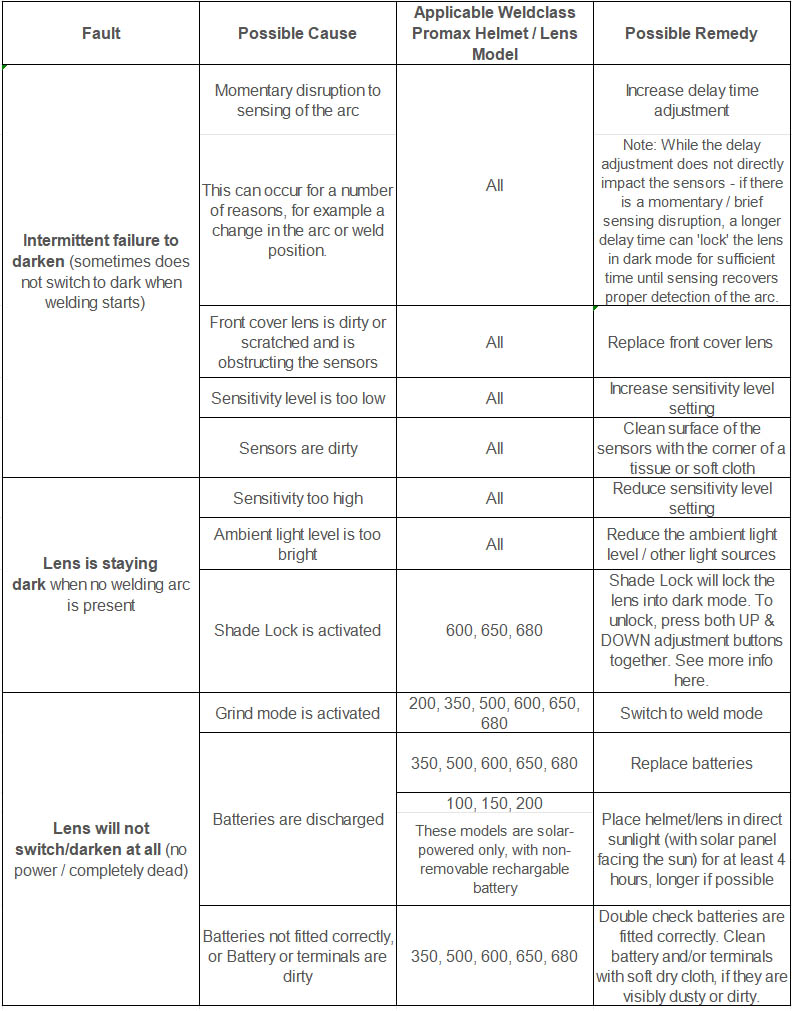
Sometimes auto darkening welding helmets causes some productivity problems. In other words, they aren’t as effective in protecting your eyes and overall head from the heat and rays of welding. While this might be a minor inconvenience, the good news is many problems you may encounter with auto darkening welding helmets are easily fixable!
This article is tips and tricks to help with electronic / auto-darkening welding helmet troubleshooting issues, most of the tips suggested will apply to other brands too.

Fixing Welding Helmet Visibility Problems
There are a number of other problems that you can run into with your welding helmet that will impact visibility.
Problem 1: Poor Visibility
Poor visibility can happen independently of everything else. You can have your helmet set to the most optimal visibility possible, and you may still not be able to see through it on occasion.
In these cases, your helmet may just be dirty. So, you can fix the issue by cleaning it.
Welding helmets collect dust and dirt like anything else. This dirt can accumulate enough to start obscuring your view.
Thus, you can fix the darkness problem just by cleaning the helmet. You should completely clean it often, especially the lens.
If cleaning does not fix the issue, you might need to replace the lens. You should not have to replace the helmet unless the lens is welded into place.
Problem 2: Darkens too Much
You should conduct a sun test every now and then if you use your welding helmet daily. A sun test will tell you if the helmet darkens too fast, which might be a sign of a faulty battery.
Short of replacing the battery, you can fix your helmet by adjusting the light sensitivity.
The sensitivity might just be too high, draining the battery. Lowering the setting may fix the problem and give you more time on the batteries.
Problem 3: Helmet Feels Unreliable
Many welding helmet problems come from an improper fit. If the helmet just does not feel right as you wear it, that might be the case with yours.
While frustrating, especially in the middle of welding, you can easily fix the problem. You just have to tighten up the straps.
Sure, the problem could be something more serious. The helmet can just be broken and unreliable. However, for most people, this is simply not the case.
Usually, the problem is just poor fitting. You just threw the helmet on without thinking if it is the right size for your head.
Fortunately, you can fix every problem you might be having just by properly fitting the helmet to your head before you use it. It might be as simple as tightening the straps and adjustments.
You can test the helmet as often as you need to get the right fit before you start welding.
If it is too tight, try loosening it instead. You should only get a new welding helmet if nothing works.
Problem 4: You Can’t See Enough of Your Weld
If you must turn your head to see what you are welding, the problem may be the size of your lens. While the lens is meant to let you see what you are doing, the lack of visibility can get frustrating.
Luckily, you can fix the problem just by using a wider lens.
Here is a quick tip. You do not need to use the lens that comes with your welding helmet. Many manufacturers produce replacement lenses you can use if the default lens does not work for you.
If a wider lens is available for your model helmet, just use it.
Wide lenses work just like any other welding lens. They are just wider.
They expand your field of view so you never have to turn your head to see what you are welding.
Problem 5: Weld Seems Too Bright
While most people find their helmets too dark, some will have the opposite problem. Especially common with doing more advance, industrial-grade projects, welding helmets can get too bright.
When that happens, you might mistakenly think your helmet has issues, leading you to do something rash.
Fortunately, you can just set the lens to a darker shade. There is nothing wrong with the helmet.
High-end projects tend to skew on the bright side naturally. You just have to readjust the helmet to a more darker shade as needed, remember to revert the settings back when done.
Problem 6: Eye Strain
There is no mechanical fix for eye strain. Once you physically overuse your eyes, you must stop what you are doing and rest.
Thus, you want to ensure you never strain your eyes while wearing your welding helmet.
However, you develop eye strain from not using a dark enough setting. Thus, you have a problem if your help does not turn on the tint quickly enough.
Fortunately, you can fix the problem by decreasing the reaction time.
The reaction time determines how fast the lens darkens. Thus, if it doesn’t tint fast enough, the response time is too long. 1/10,000 second is the recommended reaction speed, but you need to set this according to what works for your body.
Problem 7: Flickers
If the darkness turns on and off, then the problem is with the battery. If you see a flickering side sensor light or the filter stops working, you should replace the batteries.
Replacing the batteries should be simple. You might need to read the manual to figure out how to do it, but most likely your helmet is not damaged. You only need to replace the helmet if you cannot remove the battery.



